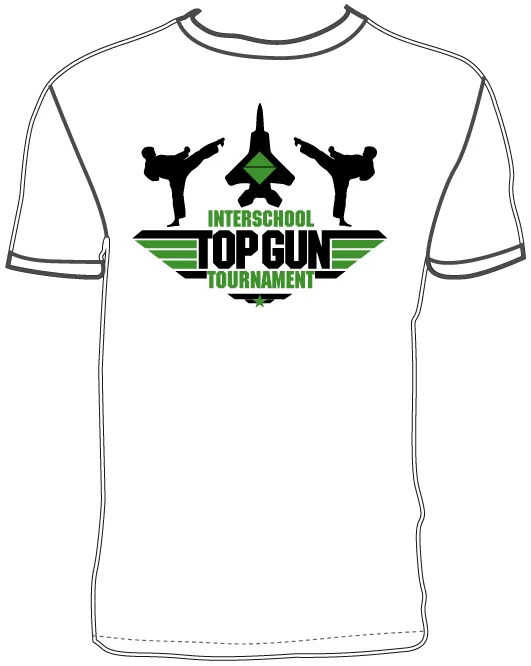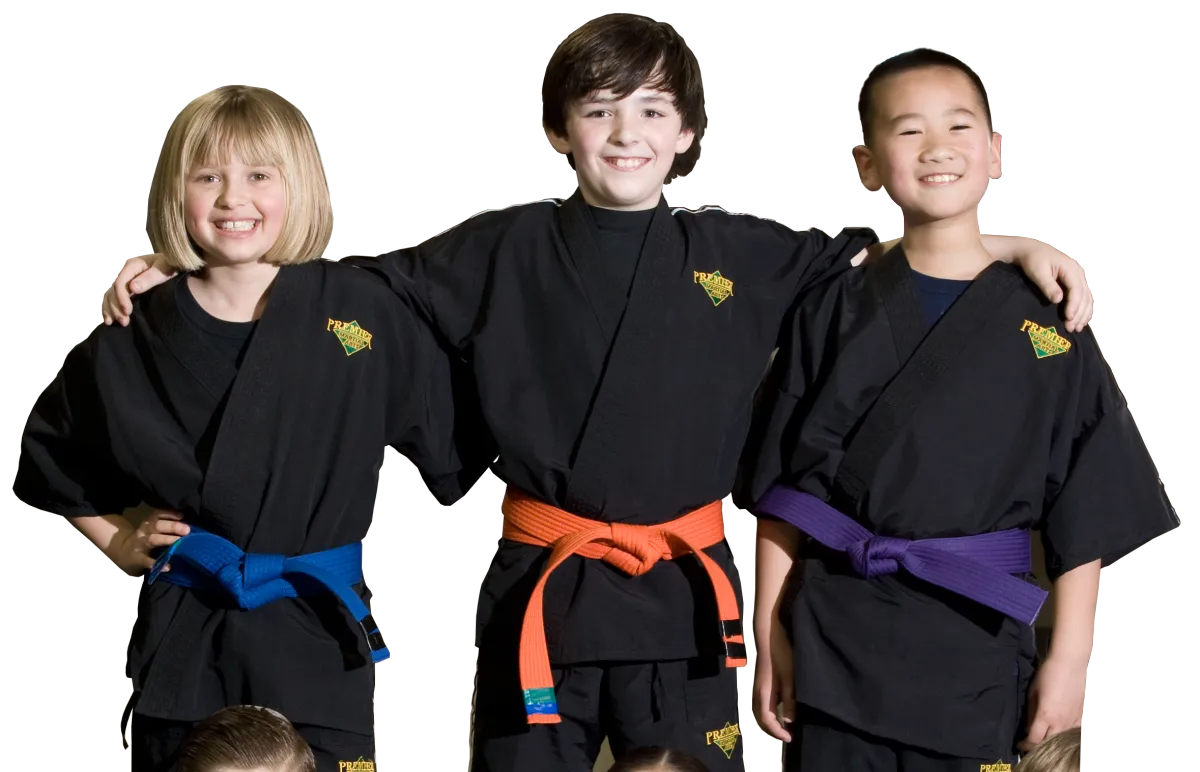


Register for the
Interschool Top Gun Tournament!
Are you ready to showcase your martial arts skills and compete with the best? The Interschool Top Gun Tournament is the perfect opportunity for martial artists of all levels to test their abilities, gain valuable experience, and make new friends from different schools. This exciting event will feature thrilling matches, expert judges, and fantastic prizes for the top performers.
Date: August 24, 2024
Location: Premier Martial Arts Rosenberg - 545 FM 2977, Rosenberg, TX 77469
Why You Should Register:
Challenge Yourself: Compete against talented martial artists from various schools and push your limits.
Gain Experience: Improve your skills and learn from each match.
Build Camaraderie: Meet and bond with fellow martial artists who share your passion.
Win Prizes: Stand a chance to win medals, trophies, and other amazing rewards.
Whether you're a seasoned competitor or new to the tournament scene, the Interschool Top Gun Tournament is an event you won't want to miss. Secure your spot now and become a part of this unforgettable martial arts experience!
$50 per competitor
(includes all events)
$25 Tournament Shirt
Shirt Order Deadline 8/14/24
DIVISIONS & SESSION TIMES
TEENS (age 13-17) : 9AM - 10AM
LITTLE CHAMPS (age 4-6) : 10AM - 12PM
JUNIORS (age 7-12) : 12PM - 2PM
Kickboxing Sparring
Flag Sparring
Weapons Combinations
Wave Master Sparring (Little Champs Only)
2 Person Krav Maga

RULES
Kickboxing (Sparring)
DEFINITION OF KICKBOXING (SPARRING) COMPETITION
Competition should be executed as its name implies, Light Contact Fighting in a Continuous Manner. Under no circumstances should light contact continuous fighting simulates full contact kickboxing. Utilizing well-controlled techniques, ring craftsmanship and combination skills, competitors should attempt to “outscore” rather than “overpower” their opponent. Competitors will fight continuously until the referee’s command to STOP. All techniques must be well controlled. Techniques should not “strike through” or “push through” the target. Striking with excessive contact, or uncontrolled striking of any kind will lead to disqualification. Emphasis must be placed on both punching and kicking techniques. Punching or “boxing” only, for an extended period of time without throwing kicks will downgrade the judge’s evaluation of your performance. Each match is carried out with running time. The referee and judges will evaluate the relative effectiveness of each fighter based on the number, quality and variety of scoring strikes, defense and conditioning. Rules violations (whether penalized by the referee or not) will downgrade the judge’s evaluation of the offending fighter.
EQUIPMENT REQUIRED
All gear must be PMA Approved, Head protection (helmet)PMA boxing gloves Shin/instep guards and/or boots.
Mouth guard
Groin protection
Full Premier Martial Arts Uniform (Pants, Crossover Top, and Belt)
TIME AND ROUNDS
Two (2) Forty-Five (45) second rounds with a 30 second break.
DIVISIONS
Students will be divided by age and rank.
LEGAL TARGET AREAS
The following parts of the body may be attacked using the authorized fighting techniques:
Head – front and side
Torso – front and side
Legs – Inside and outside (above knee)
LEGAL TECHNIQUES - SCORING
Both hand and foot strikes should be used. In evaluating each fighter’s performance, the judges will give more credit to the athlete that is effective with a balanced attack of kicks and punches thrown in combination. Punching or “boxing” only for an extended period of time without throwing kicks may be cause for penalization or may downgrade the judge’s evaluation of a fighter’s performance. The authorized striking area of the hand or foot may only make “Clean/ Controlled” Light contact. The fighter must be looking at the point of contact when executing the technique. All techniques must be well executed. Weak techniques or techniques that simply touch or brush or push an opponent will not be scored. Excessive contact, mauling, pushing or rough housing, will be grounds for penalization, downgrading in the judges’ evaluation and/or disqualification. If a fighter jumps in the air to attack, he must land inside the ring to score, and he must keep his balance (it is not allowed to touch the floor with any part of the body except the feet).
LEGAL HAND TECHNIQUES
The following hand techniques may be applied:
Ridge hand,
Punches,
Backfist (Not Spinning Back Fist)
LEGAL FOOT TECHNIQUES
The following hand techniques may be applied:
Front kick
Side kick
Round kick
Heel kick (sole of the foot only),
Crescent kick,
Axe kick (sole of the foot only)
Jump kicks
ILLEGAL TARGET AREAS - PROHIBITED TECHNIQUES AND PROHIBITED BEHAVIOR
Any technique not listed as legal above, or striking any target not listed as legal above, including, but not limited to the following:
IT IS PROHIBITED TO:
Attack the throat, lower abdomen, kidneys, back, joints, groin and to the back of the head or neck.
Attack with the knee, elbow, knife-hand, head-butts, thumb and shoulder or a spinning hand strike.
Turn one’s the back to the opponent, run away, fall down, intentional clinching, blind techniques, wrestling and ducking below opponent’s waist.
Attack an opponent who is falling to the floor or is already on the floor, that is, as soon as one hand or knee touches the floor.
Leave the ring without any permission.
Continue after the command “stop” or “break” or the end of the round has been sounded.
Oil the face or body.
Hooking, tripping, and hitting with knees or elbows.
Butting with the head, shoulders, forearms, and elbows, strangling the opponent, crushing his face with arm or elbow and pushing back the opponent.
Hitting with open gloves, with the inside of the gloves or with a wrist.
Hitting the opponent’s back, particularly on the nape of his neck, head, and kidneys.
Lying down, wrestling or not fighting at all.
Attacking an opponent who is on the floor or getting up.
Clinching without any reason.
Hitting while hooking the opponent, or pulling the opponent, into the blow.
Hooking or holding opponent’s arm or putting an arm underneath the arm of the opponent.
Suddenly lowering one’s head below opponent’s belt in a way that would be dangerous for the latter.
Using artificial means for a passive defense and falling down intentionally, in order to avoid a blow.
“Spoiling”.
Intentionally preventing your opponent from engaging you by moving around the ring or clinching your opponent to cut down on round time.
Using insulting and aggressive language during a round.
Refusing to withdraw after the order “BREAK”.
Trying to land a blow on the opponent immediately after a “BREAK” order and before withdrawing.
Assailing or insulting the referee at any time.
Exiting the ring during the fighting competition
WARNINGS FOULS AND DISQUALIFICATIONS
Violations of the rules and regulations will lead to cautions, warnings, and/or disqualification. Referees may warn, penalize a competitor at their discretion depending upon the severity or repetitive nature of the rule violation.
The Center Referee is the arbiter of the rules. If he perceives that a violation has occurred, he/she has the discretion to issue one of the following:
A Caution
A “Caution” may be issued without stopping the action of the fight.
An Official Warning
An “Official Warning” is issued by stopping action of the fight. The “Official Warning” indicates that if the referee must stop the match again for the same or a similar infraction the offending athlete will be disqualified.
DISQUALIFICATIONS
A “Disqualification” awards the match to the offending fighter’s opponent.
The referee has the complete discretion to use Cautions, Warnings and Disqualification according to the severity of the offense. A fighter does not have to be Cautioned to receive an Official Warning. Nor does he have to receive an Official Warning prior to being Disqualified.
The following may lead to immediate disqualification:
Excessive contact resulting in an injury
Repeatedly striking with excessive contact
Uncontrolled or malicious attacks
Excessive or continuous hitting after “stop” command
Extreme unsportsmanlike conduct of a fighter such as insulting the referee or the opponent
INJURIES
The match should be interrupted if an injury occurs. In the event of injury, time may only be interrupted until the doctor decides on the seriousness of the injury, that is, whether the fight can continue, or whether it must be stopped. Treatment of the injury can only be done in between rounds or after the match. If the injury needs to be treated, the match must be stopped. In any case, cuts cannot be taped. If the match is stopped due to injury, the officials must decide:
Who caused the injury?
Whether or not it was intentional.
Whether or not it was self-inflicted.
If the injury was not intentional and the injured fighter cannot continue fighting immediately, the uninjured fighter is declared the winner.
If the injury is due to a violation of the rules, the responsible fighter may be disqualified.
If the injury is due to his own fault, the uninjured fighter is declared the winner.
REFERIES POWERS AND RESPONSIBILITIES
Stop a fight at any moment if he finds it to be too one-sided.
Stop a fight at any moment if one of the fighters has received an unauthorized blow or is wounded, or if he considers a fighter unable to continue.
Stop a fight at any moment if he finds the fighters behaving in an “unsportsmanlike” manner. In such a case, he must disqualify one fighter.
Warn a fighter or stop the bout and give a minus point or warning to a fighter for an offence.
Disqualify a coach or a second who has broken the regulations or the fighter himself if his coach or the second fails to obey to his orders.
Disqualify, with or without a warning, a fighter who has committed an offence.
Interpret the rules, as long as, they are applicable or compatible with the fight that is taking place, or, at a special moment, decide on a move which does not appear in the rules.
JUDGES SCORING SYSTEM
Every round is separately evaluated by each of the judges according to a positive criteria that will gain a fighter points and negative criteria that will deduct points:
Positive Judges Criteria (That Will Earn a Fighter Credit towards Victory)Clean and controlled scoring punches and kicks
The demonstration of effective combination striking
The effectiveness of the fighter’s defense
The variety of strikes used (hands and feet)Excellent physical condition
Negative Judges Criteria (That Will Reduce a Fighters Credit towards Victory)Rules Violations whether cautioned or warned by the referee or not
Cautions and/or Warning by the referee for rules violations
“Bullying”, or any effort to overpower an opponent rather than demonstrate superior skill
Lack of combination striking
Lack of variety in strikes (hands and feet)Poor physical condition
Point Values and Winner Determination
1 Point will be awarded for any legally scored technique
FLAG SPARRING COMPETITION
DEFINITION AND GENERAL GUIDELINES
The Flag Sparring Competition is for Tiny Champs, Little Champs, and students in the Basic Program only. Any students enrolled in Black Belt Training or Premier Training (excluding Tiny and Little Champs) cannot compete in this event.
The purpose of this event is to introduce our Tiny and Little Champs and our Basic Program students to sparring in a fun and safe way.
GROUPING
Competitors will be divided according to age and rank.
DIVISIONS
Divisions will be combined for both male and female.
Competitors will be shuffled to determine the order of competition. In the instance there is an odd number of competitors, groups may be combined or divided at the referee’s discretion.
TIME LIMIT
Competitors will have a maximum of two (2) minutes to grab both of their opponent’s flags
SCORING
Each competitor will have two (2) flags inserted into their belt.
When the referee says “go” they will attempt to reach in and grab one (1) their opponent’s flag and pull it out
Flags can only be pulled out one (1) at a time.
Blocking is allowed but must be controlled
You must be standing to grab a flag.
You cannot fall down and grab a flag.
WARNINGS, FOULS, AND DISQUALIFICATIONS
While rare in flag sparring multiple warnings/fouls will result in a disqualification. Disqualifications are at the sole discretion of the referee.
POSSIBLE WARNINGS AND FOULS MAY INCLUDE:
Holding your own flag to prevent it from being pulled out
Pulling more than one of your opponent’s flags at one time
Grabbing any other part of your opponent’s body or uniform
Unsportsmanlike conduct of a fighter such as insulting or arguing with the referee or the opponent
LITTLE CHAMP WAVEMEASTER SPARRING
DEFINITION AND GENERAL GUIDELINES
Little Champ Wavemaster Sparring Competition is for Little Champs only. No other students may compete in this event. The purpose of this event is to introduce our Tiny and Little Champ Program students to sparring in a fun and safe way.
Emphasis must be placed on both punching and kicking techniques. Punching or “boxing” only, for an extended period of time without throwing kicks will downgrade the judge’s evaluation of your performance.
Each match is carried out with running time. The referee and judges will evaluate the relative effectiveness of each fighter based on the number, quality and variety of scoring strikes, defense, and conditioning.
GROUPING
Competitors will be divided according to age and rank.
DIVISIONS
Divisions will be combined for both male and female.
Competitors will be shuffled to determine the order of competition. In the instance there is an odd number of competitors, groups may be combined or divided at the referee’s discretion.
TIME LIMIT
Competitors will have a maximum of thirty (30) seconds to throw as many fighting combinations at the Wavemaster as possible.
SCORING
Every round is separately evaluated by each of the judges according to a positive criteria that will gain a fighter points including clean and controlled scoring punches and kicks and the variety of strikes used (hands and feet)
Students will compete side by side two (2) at a time.
The judges and referee will choose a winner of each round by pointing to the fighter that they feel demonstrated the best quality and variation of kicks and punches.
TWO PERSON KRAV MAGA COMPETITION
DEFINITION AND GENERAL GUIDELINES
Teams demonstration routines should be performed and executed in a manner to accurately reflect a competitor’s knowledge, skill, and ability to execute and to apply the self-defense combinations of Krav Maga in practical situations.
Competitors must perform demonstration routines in groups of two.
Teams must be grouped according to age and rank.
Teams may consist of boys, girls, or both.
Teams will be grouped by age and level
Teams will be placed in the division of the oldest member of the team
Teams will be placed in the highest level of the team
Example: If a Basic Training student and a Black Belt Training student are on a team, they will compete in the Black Belt Training level divisions
Self-defense techniques will be performed “One for One”
Team members will alternate attacking and defending until time runs out.
GROUPING
Competitors will be divided according to age and rank.
DIVISIONS
Divisions will be combined for both male and female.
Competitors will be shuffled to determine the order of competition. In the instance there is an odd number of competitors, groups may be combined or divided at the referee’s discretion.
TIME LIMIT
Competitors will have a maximum of one (1) minute to set up and to perform their routine. The timer will start once the competitors are ready and the referee says go.
SCORING
Teams will compete against other teams in a bracketed competition
Two teams will compete, one team at a time, and then based on the criteria below, the judges will point to the team that one the match.
The winning team moves up in the bracket
Competitors will be judged on the following criteria:
Practicality
Showmanship
Difficulty of techniques and combinations
Appropriateness of techniques
PROPS
The following props are allowed in this division for teen competitors only.
Rubber Gun
Rubber or Aluminum Unsharpened Knife
Kali Stick or Padded Club
WEAPONS COMBINATIONS and WEAPONS FORMS COMPETITION
GROUPING
Competitors will be divided according to age and rank.
DIVISIONS
Divisions will be combined for both male and female.
Competitors will be shuffled to determine the order of competition. In the instance there is an odd number of competitors, groups may be combined or divided at the referee’s discretion.
Forms competitors will be seperated from combination competitors.
COMPETITION PROCEDURES - WEAPONS COMBO COMPETITION
Competitors will compete with either the Bo or the Nunchakus
Competitors will choose three of their Combos to compete with.
Competitors will compete side by side in a bracket style competition.
After each combination judges will score the best combo by pointing to the competitor, they feel had the best Power, Control, and Spirit.
After three (3) rounds the competitor that wins the most matches will be declared the winner of the round and will move forward in the bracket
WEAPONS FORMS COMPETITION
Competitors will compete with Either the Bo, Nunchakus, Sword, or Kamas
Competitors will compete side by side in a bracket style competition
If more room is needed them competitors will compete separately before being scored.
After each form, judges will score the best form by pointing to the competitor they feel had the best Power, Technique, and Spirit in their form.
The winner of the round and will move forward in the bracket
DROPPING A WEAPON
If an Advanced or Black Belt competitor drops his/her weapon, they will not be scored and will be disqualified. They are encouraged to complete their form but are not required to continue.
If a beginner or intermediate competitor drops his/her weapon, they will be allowed to restart their form one (1) time with no penalty.
Restarting a second time will result in no score.
If a competitor drops their weapon and it goes out of bounds or hits anyone, they will be disqualified and will not receive any score.
ALTERING A WEAPON
It is the intent, of this rule, to enforce the use of approved PMA weapons in their original design, functionally, and capabilities.
Altering the weapon(s) in any matter (excluding tape), including but not limiting to the use of magnetic weapons, will be deemed as altering the weapon and the competitor will not be allowed to compete with that weapon.
WEAPONS RING BOUNDRIES
All forms should be performed within the confines of the competition ring.
The intent of this rule is the safety of competitors, spectators, and the judges; also, known as the group. It is not intended to be applied unilaterally; rather in situations where the exceeding of the imaginary boundary could provide a risk to any of the group.
Examples of this rule are:
A competitor or their weapon(s) or some portion of their weapon(s) exceed the boundary of the ring, including an imaginary line that goes vertically from the boundary floor line upward.
The competitor's weapon goes between or over the group's body or head; or
The competitor's weapon hits anyone, in the group, who is outside of the ring.
WEAPONS COMPETITION PENALTIES
In the Form and Weapon Divisions, all penalties, non-disqualification, are per judge and will be deducted from the offending competitor’s final score
Penalties are as follows:
Dropping or throwing a Weapon down:
In Advanced and Black Belt division – Disqualification
In Beginner and Intermediate Belt division – No Penalty if dropped, disqualification if thrown
A portion of a weapon leaves the ring area
Boundary Rule – without the request to exceed ring boundary:
The weapon goes between or over the group's body or head
Starting a Form or Weapon routine over
In Advanced and Black Belt division – Disqualification
In Beginner and Intermediate Belt division – No Penalty
Weapon Breaks – separates into 2 or more sections
The weapon hits anyone, in the group
Unsportsmanlike like conduct